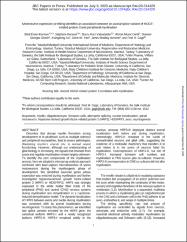| dc.contributor.author | Kerman, Bilal Ersen | |
| dc.contributor.author | Genoud, Stephane | |
| dc.contributor.author | Kurt Vatandaşlar, Burcu | |
| dc.contributor.author | Denli, Ahmet Murat | |
| dc.contributor.author | Ghosh, Shereen Georges | |
| dc.contributor.author | Xu, Xiangdong | |
| dc.contributor.author | Yeo, Gene W. | |
| dc.contributor.author | Aimone, James Bradley | |
| dc.contributor.author | Gage, Fred H. | |
| dc.date.accessioned | 2020-09-28T10:52:34Z | |
| dc.date.available | 2020-09-28T10:52:34Z | |
| dc.date.issued | 2020 | en_US |
| dc.identifier.citation | Kerman, B. E., Genoud, S., Kurt Vatandaşlar, B., Denli, A. M., Ghosh, S. G., Xu, X. ... Gage, F. H. (2020). Motoneuron expression profiling identifies an association between an axonal splice variant of HDGF-related protein 3 and peripheral myelination. Journal of Biological Chemistry, 295(34), 12233-12246. https://dx.doi.org/10.1074/jbc.RA120.014329 | en_US |
| dc.identifier.issn | 0021-9258 | |
| dc.identifier.issn | 1083-351X | |
| dc.identifier.uri | https://dx.doi.org/10.1074/jbc.RA120.014329 | |
| dc.identifier.uri | https://hdl.handle.net/20.500.12511/5876 | |
| dc.description.abstract | Disorders that disrupt myelin formation during development or in adulthood, such as multiple sclerosis and peripheral neuropathies, lead to severe pathologies, illustrating myelin's crucial role in normal neural functioning. However, although our understanding of glial biology is increasing, the signals that emanate from axons and regulate myelination remain largely unknown. To identify the core components of the myelination process, here we adopted a microarray analysis approach combined with laser-capture microdissection of spinal motoneurons during the myelinogenic phase of development. We identified neuronal genes whose expression was enriched during myelination and further investigated hepatoma-derived growth factor-related protein 3 (HRP3 or HDGFRP3). HRP3 was strongly expressed in the white matter fiber tracts of the peripheral (PNS) and central (CNS) nervous systems during myelination and remyelination in a cuprizone-induced demyelination model. The dynamic localization of HPR3 between axons and nuclei during myelination was consistent with its axonal localization during neuritogenesis. To study this phenomenon, we identified two splice variants encoded by theHRP3gene: the canonical isoform HRP3-I and a newly recognized isoform, HRP3-II. HRP3-I remained solely in the nucleus, whereas HRP3-II displayed distinct axonal localization both before and during myelination. Interestingly, HRP3-II remained in the nuclei of unmyelinated neurons and glial cells, suggesting the existence of a molecular machinery that transfers it to and retains it in the axons of neurons fated for myelination. Overexpression of HRP3-II, but not of HRP3-I, increased Schwann cell numbers and myelination in PNS neuron-glia co-cultures. However, HRP3-II overexpression in CNS co-cultures did not alter myelination. | en_US |
| dc.description.sponsorship | Christopher and Dana Reeve Foundation
Roche Foundation
Swiss National Science Foundation (SNSF)
American Heart Association
Paul G. Allen Frontiers Group Grant
Leona M. and Harry B. Helmsley Charitable Trust Grant
Grace Foundation
JPB Foundation
Robert and Mary Jane Engman Foundation
Ray and Dagmar Dolby Family Fund
Crick-Jacob Center for Theoretical and Computational Biology
Neurosurgery Neuroscience Consortium Fellowship | en_US |
| dc.language.iso | eng | en_US |
| dc.publisher | American Society for Biochemistry and Molecular Biology Inc | en_US |
| dc.rights | info:eu-repo/semantics/openAccess | en_US |
| dc.subject | Myelin | en_US |
| dc.subject | Oligodendrocyte | en_US |
| dc.subject | Schwann Cells | en_US |
| dc.subject | Alternative Splicing | en_US |
| dc.subject | Nuclear Translocation | en_US |
| dc.subject | Spinal Motoneuron | en_US |
| dc.subject | Hepatoma-Derived Growth Factor-Related Protein 3 (HRP3) | en_US |
| dc.subject | HDGFRP3 | en_US |
| dc.subject | Axon | en_US |
| dc.subject | Neuritogenesis | en_US |
| dc.title | Motoneuron expression profiling identifies an association between an axonal splice variant of HDGF-related protein 3 and peripheral myelination | en_US |
| dc.type | article | en_US |
| dc.relation.ispartof | Journal of Biological Chemistry | en_US |
| dc.department | İstanbul Medipol Üniversitesi, Uluslararası Tıp Fakültesi, Temel Tıp Bilimleri Bölümü, Histoloji ve Embriyoloji Ana Bilim Dalı | en_US |
| dc.department | İstanbul Medipol Üniversitesi, Rektörlük, Rejeneratif ve Restoratif Tıp Araştırmaları Merkezi (REMER) | en_US |
| dc.department | İstanbul Medipol Üniversitesi, Sağlık Bilimleri Enstitüsü, Sinirbilim Ana Bilim Dalı | en_US |
| dc.authorid | 0000-0003-1106-3288 | en_US |
| dc.identifier.volume | 295 | en_US |
| dc.identifier.issue | 34 | en_US |
| dc.identifier.startpage | 12233 | en_US |
| dc.identifier.endpage | 12246 | en_US |
| dc.relation.tubitak | info:eu-repo/grantAgreement/TUBITAK/SOBAG/116S059 | |
| dc.relation.publicationcategory | Makale - Uluslararası Hakemli Dergi - Kurum Öğretim Elemanı | en_US |
| dc.identifier.doi | 10.1074/jbc.RA120.014329 | en_US |
| dc.identifier.wosquality | Q2 | en_US |
| dc.identifier.scopusquality | Q1 | en_US |


















